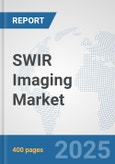The report on SWIR imaging market is a comprehensive study and presentation of drivers, restraints, opportunities, demand factors, market size, forecasts, and trends in the global SWIR imaging market over the period of 2022-2032. Moreover, the report is a collective presentation of primary and secondary research findings.
Porter's five forces model in the report provides insights into the competitive rivalry, supplier and buyer positions in the market and opportunities for the new entrants in the global SWIR imaging market over the period of 2022-2032. Furthermore, the growth matrix given in the report brings an insight into the investment areas that existing or new market players can consider.
Report Findings
1) Drivers
- Increasing use in military and defense applications is driving the growth of the SWIR imaging market.
- Growing demand for SWIR in industrial inspection and quality control is propelling market growth.
2) Restraints
- High initial cost and integration challenges are expected to hamper market expansion.
3) Opportunities
- The expansion of SWIR imaging application in consumer electronics will create market growth opportunities.
Research Methodology
A) Primary Research
The primary research involves extensive interviews and analysis of the opinions provided by the primary respondents. The primary research starts with identifying and approaching the primary respondents, the primary respondents are approached include1. Key Opinion Leaders
2. Internal and External subject matter experts
3. Professionals and participants from the industry
The primary research respondents typically include
1. Executives working with leading companies in the market under review2. Product/brand/marketing managers
3. CXO level executives
4. Regional/zonal/ country managers
5. Vice President level executives.
B) Secondary Research
Secondary research involves extensive exploring through the secondary sources of information available in both the public domain and paid sources. Each research study is based on over 500 hours of secondary research accompanied by primary research. The information obtained through the secondary sources is validated through the crosscheck on various data sources.The secondary sources of the data typically include
1. Company reports and publications2. Government/institutional publications
3. Trade and associations journals
4. Databases such as WTO, OECD, World Bank, and among others.
5. Websites and publications by research agencies
Segment Covered
The global SWIR imaging market is segmented on the basis of offering, technology, imaging type, and vertical.The Global SWIR Imaging Market by Offering
- Solution
- Services
The Global SWIR Imaging Market by Technology
- Cooled
- Uncooled
The Global SWIR Imaging Market by Imaging Type
- Spectral Imaging
- Thermal Imaging
- Hyperspectral Imaging
The Global SWIR Imaging Market by Vertical
- Electronics and Communication
- Military and Defence
- Medical and Healthcare
- Food & Beverage
- Automotive
- Others
Company Profiles
The companies covered in the report include
- Teledyne FLIR LLC
- Corning Incorporated
- Collins Aerospace
- Allied Vision Technologies GmbH
- Leonardo DRS
- Hamamatsu Photonics K.K.
- Fluke Corporation
- New Imaging Technologies (NIT)
- Raptor Photonics
- Lynred
What does this report deliver?
1. Comprehensive analysis of the global as well as regional markets of the SWIR imaging market.2. Complete coverage of all the segments in the SWIR imaging market to analyze the trends, developments in the global market and forecast of market size up to 2032.
3. Comprehensive analysis of the companies operating in the global SWIR imaging market. The company profile includes analysis of product portfolio, revenue, SWOT analysis and latest developments of the company.
4. Growth Matrix presents an analysis of the product segments and geographies that market players should focus to invest, consolidate, expand and/or diversify.








